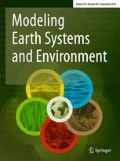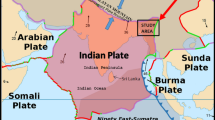Abstract
Euler deconvolution technique is one of the methods that predicts the subsurface features and structures with help of gravity modelling. The present study was performed to identify the earth’s geothermal potentials in Dholera, Unai, and Gandhar regions of Gujarat, India using gravity technique. The structures and layers of the subsurface were determined by performing the gravity survey and the interpretation of data was carried out using Euler Deconvolution. The survey was conducted along six profile lines: five horizontal and one perpendicular to others in the study areas. After acquiring gravity data, various corrections were applied to convert raw gravity data to corrected Bouguer gravity data. In this paper density of the subsurface formation has been determined using Nettleton and Parasnis methods, which suggests that the subsurface of Dholera, Unai, and Gandhar have densities close to sedimentary rocks. After density determination, regional and residual separation was performed on the Bouguer gravity data to get information on geothermal causative bodies. In this paper, the Euler Deconvolution method was applied to interoperate the spatial position and depth of the subtle geothermal bodies. The Euler solutions for depth in Dholera, Unai, and Gandhar range between 1324–4300 m, 1877–4813 m, and 2345–5536 m. The results of gravity Euler Deconvolution suggests the presence of geothermal potential in these regions.










Similar content being viewed by others
References
Abdelrahman EM, Abo-Ezz ER (2008) A least-squares standard deviation method to interpret gravity data due to finite vertical cylinders and sheets. Pure Appl Geophys 165(5):947–965
Abdelrahman EM, El-Araby TM (1996) Shape and depth solutions from moving average residual gravity anomalies. J Appl Geophys 36(2–3):89–95
Abdelrahman EM, El-Araby TM, El-Araby HM, Abo-Ezz ER (2001) A new method for shape and depth determinations from gravity data. Geophysics 66(6):1774–1780
Abdelrahman EM, Abo-Ezz ER, Essa KS, El-Araby TM, Soliman KS (2006) A least-squares variance analysis method for shape and depth estimation from gravity data. J Geophys Eng 3(2):143–153
Abiye TA, Haile T (2008) Geophysical exploration of the Boku geothermal area, Central Ethiopian Rift. Geothermics 37(6):586–596
Beltrao JF, Silver JBC, Costa JC (1991) Robust polynomial fitting method for regional gravity estimation. Geophysics 56:80–89
Cooper GRJ (2013) Reply to a discussion about the ‘Hyperbolic tilt angle method’ by Zhou et al. Comput Geosci 52:496–497
Cooper GRJ, Cowan DR (2006) Enhancing potential field data using filters based on the local phase. Comput Geosci 32(10):1585–1591
ElDawi MG, Tianyou L, Hui S, Dapeny L (2004) Depth estimation of 2-D magnetic anomalous sources by using Euler deconvolution method. Am J Appl Sci 1(3):209–214
Essa KS (2007) Gravity data interpretation using the s-curves method. J Geophys Eng 4(2):204–213
Fairhead JD, Bennett KJ, Gordon DRH (1994) Euler: beyond the “black box”[J]. Seg Tech Progr Expand Abstr 13(1):1679
Ferreira FJ, de Souza J, de B. e S. Bongiolo A, de Castro LG (2013) Enhancement of the total horizontal gradient of magnetic anomalies using the tilt angle. Geophysics 78(3):33–41
Gottsmann J, Camacho AG, Martí J, Wooller L, Fernández J, García A, Rymer H (2008) Shallow structure beneath the Central Volcanic Complex of Tenerife from new gravity data: implications for its evolution and recent reactivation. Phys Earth Planet Inter 168:212–230
Keating P, Pilkington M (2004) Euler Deconvolution of the analytic signal and its application to magnetic interpretation. Geophys Prospect 53:165–182
Li W, Xue L (2015) Heat production rate of radioactivity in rocks [J]. Int J Earth Sci Eng 8(1):59–66
Lu BL, Fan MN, Zhang YQ (2009) The calculation and optimization of structure index in Euler deconvolution [J]. Prog Geophys 24(3):1027–1031
Mallick K, Vasanthi A, Sharma KK (2012) Bouguer gravity regional and residual separation: application to geology and environment. Springer, Dordrecht, ISBN: 978-94-007-0406-0. https://doi.org/10.1007/978-94-007-0406-0
Montesinos FG, Camacho AG, Nunes JC, Oliveira CS, Vieira R (2003) A 3-D gravity model for a volcanic crater in Terceira Island (Azores). Geophys J Int 154:393–406
Nettleton LL (1976) Gravity and magnetic in oil prospecting. McGraw-Hill Book Co, New York
Reid AB (1995) Euler deconvolution, past, present and future: a review. In: Proceedings in applications of regional geophysics and geochemistry, SEG, paper 113, pp 861–863
Reid AB, Allsop JM, Granser H, Millett AJ, Somerton IW (1990) Magnetic interpretation in three dimensions using Euler deconvolution. Geophysics 55(1):80–91
Represas P, Santos FA, Ribeiro J (2013) Interpretation of gravity data to delineate structural features connected to low-temperature geothermal resources at Northeastern Portugal. J Appl Geophys 92:30–38
Salem A, Furuya S, Aboud E, Elawadi E, Jotaki H, Ushijima K (2005) Subsurface structural mapping using gravity data of Hohi Geothermal Area, Central Kyushu, Japan. In: Proceedings in world geothermal congress. Antalya, Turkey
Schiavone D, Loddo M (2007) 3-D density model of Mt. Etna Volcano (Southern Italy). J Volcanol Geotherm Res 164:161–175
Soengkono S (2011) Deep interpretation of gravity and airborne magnetic data over the Central Taupo Volcanic Zone. In: Proceedings in New Zealand geothermal workshop (21–23 November 2011). Auckland, New Zealand
Thompson DT (1982) EULDPH: a new technique for making computer-assisted depth estimates from magnetic data. Geophysics 47(1):31–37
Verduzco B, Fairhead JD, Green CM, MacKenzie C (2004) New insights into magnetic derivatives for structural mapping. Lead Edge 23(2):116–119
Author information
Authors and Affiliations
Corresponding author
Additional information
Publisher's Note
Springer Nature remains neutral with regard to jurisdictional claims in published maps and institutional affiliations.
Rights and permissions
About this article
Cite this article
Yadav, K., Sircar, A. Modelling of earth’s geothermal subtle traps using gravity Euler deconvolution. Model. Earth Syst. Environ. 7, 2769–2777 (2021). https://doi.org/10.1007/s40808-020-01067-3
Received:
Accepted:
Published:
Issue Date:
DOI: https://doi.org/10.1007/s40808-020-01067-3




